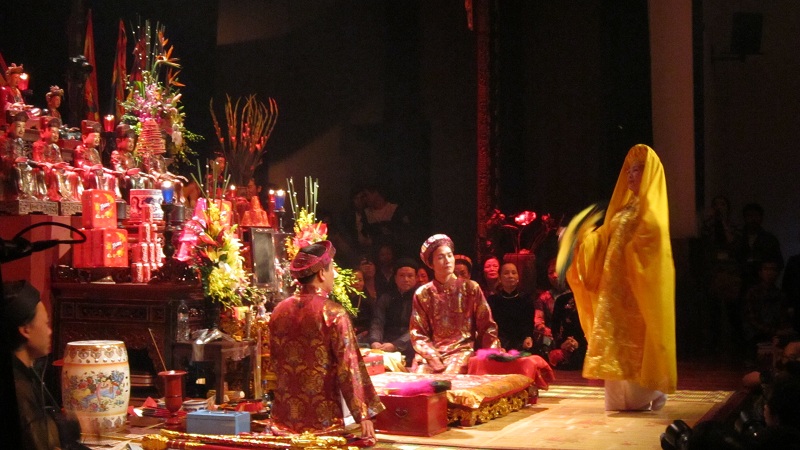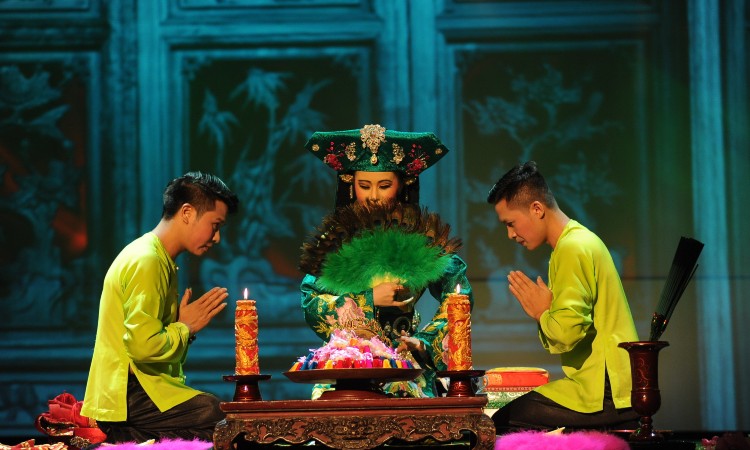Some adherents to the local belief of Mother Goddess are considered chosen ones of must respond to the call.
Sitting around a smoky table in a trendy café, we could have been just like any other group of people discussing work, the weather, or even the fortunes of the local sports team, but the topic carried a bit more weight and the stakes were as high as they come. There were three of us – two local people and myself – with one woman translating for me as another young woman opened up about her religious journey and the path she has taken to become an instrument of God. She looked like a normal, well-adjusted millennial sipping on an iced tea, but her lips spoke of being called from on high and her meeting with deities after traversing the spiritual plane.
The groundwork of Mother Goddess Worship, or “Dao Mau” in Vietnam
The young woman’s name is Hanh and before I can elaborate on her experience I should lay some groundwork for the religion she practices. Mother Goddess Worship is an indigenous religion in Vietnam, though its roots are in many different places. Just as in the West, when we look at modern Christianity we see a blend of the original Abrahamic tradition integrated with the pagan rituals of ancient Europeans, the modern rituals of Mother Goddess Worship or the cult of the Mother Goddess is an amalgam of many prehistoric traditions surrounding rice cultivation and female worship, with a more organized framework – borrowed from Chinese Taoism.

“Mother Goddess Worship belief and the trance ceremony has been practiced in Vietnam even before the Lý Dynasty in 1009” by Dr. Nguyen Ngoc Ma
The doctrines of Taoism are far too expansive to elaborate on here, but suffice it to say it has contributed a whole host of beliefs dealing with the spirits of ancestors as well as the consciousness of the elements. This fits perfectly when combined with the animism of early Vietnamese society because when agriculture is involved it is very important to please the supernatural forces you believe are controlling the natural world.

“Mother Goddess worship, or Dao Mau”, remains one of the most popular beliefs and plays an important part in people’s spiritual life in Vietnam – an agriculture-based country, where farmers strongly depend on nature.”
In Vietnam, the idea of “female” has been linked with the rice harvest and the worship of women not only honors the women who do such a large part of the farm work but is also symbolic of the worship of life, which comes from women and rice. As the worship practice developed, a pantheon of important Vietnamese figures has been added to the structure, ultimately turning this into a unique experience unlike any of the original contributors.
A personal story about “Dao Mau” of the young woman named Hanh
While sitting in the café with Hanh, I expected to hear a long history of the gods and goddesses or perhaps a recount of who the mother is. However, she told me that her knowledge is more personal since she was discouraged by her family, who are also practitioners, from learning about the Mother Goddess from the academic sources. She has, instead, gained her insights from meditation and dreams, which upon hearing I began to realize is something far deeper than simple ancestor worship and rather taps into the unconscious foundation of what it means to be human.
Her road to channeling divinities started in her childhood.
She grew up surrounded by these practices and beliefs, so she was accustomed to much of what has happened, only seeing it told from others’ perspectives. Many people told her throughout her life that she was a chosen one, that she would be called to be a medium, but she could not start her journey until the call came from within herself. This moment happened for her in a dream, when she was alone in the darkness staring out into the light. A landscape of mountainous greenery stood before her, but she was confined and lonely in a dim part of a bountiful world. All of a sudden, a woman clad in green silken garments descended to take her by the hand and lead her into illumination. Upon waking she knew that she had been chosen and could begin her arduous quest.
Even though this experience is personalized to fit her religion and character, it parallels the Hero Archetype. The Hero Archetype, or the idea of the monomyth, is the postulation that all mythical stories and all religious imagery follow a similar structure that highlights specific human qualities. This could be a narrow, and possibly cynical, view of the mythologies, but it could be something inside us that compels us to repeat these lessons to ourselves no matter where we are in the world, using the iconography available to us in that time and place.
The first step in the Hero’s Quest is the call to adventure.
This is where an ordinary person gets thrust into extraordinary circumstances and is given a task by a supernatural being. Hanh told me exactly what happened to her without knowing that she was telling me a tale as old as time. She then told me how some of those who are chosen will refuse the call, which is the next possible step in the Hero mythos. When someone in her religion refuses the call, they can experience many terrible things in their life: sickness, mental stress, and even so far as being tormented by spirits.
“The only way a chosen one can rid themselves of these maladies is by accepting their birthright and following the goddess who chose them.”
The next phase of the training after accepting the call
Hanh accepted her call because she is familiar with her beliefs and understands the consequences of not giving herself fully to her life’s purpose. Once called, she then began the next phase of her training. This is where she meditates to gain the insight necessary to embark on the more difficult part of the journey. After 100 days of preliminary instruction that she receives from communing with the goddess in her meditation, she had her first ritual.
At this point in the great myths and legends, the Hero must descend into the underworld, or what is known as entering the belly of the beast. This is where the true test of will happens, and finally, the Hero undergoes such great strain that they must ultimately transform into a greater being. This is the part of the story where Buddha gains enlightenment, Christ rises from the dead, or Luke Skywalker uses the force to destroy the Death Star.
“Statues of Mother Goddess have three Realms, including the heaven in the center, the mountains on the left, and the water on the right”
Like all great human stories, Hanh also must pass into the underworld.
During the ritual she is placed under the drape, symbolizing her descent into a plane separate from our own. She is then confronted by three main goddesses, who watch her, and if she is worthy she is then saddled by many different lower-ranking gods and goddesses. This is where her series of trials begins. Each trial is different based on which deity gives the command, but she had to racehorses with royalty, drink with gods, and even fight bravely in historic battles. These rituals can last for hours to us looking on from the outside, but the time that passes under the drape can last lifetimes. Once she has undergone these trials the drape can be removed from her head and she can come back into our world as a greater and hopefully enlightened being.
At the bottom line…
I sat amazed at such a genuine telling of her experience. I am a skeptic in many regards, though I could not help but fully believe everything she told me. We finished our drinks and went home later than expected, but what she said stuck with me. The power of the Mother Goddess might be something behind the eyes of only the Vietnamese, but perhaps no matter what we believe, the power – of the hero lies within all of us.
Contact Us
Lux Travel DMC specializes in custom-made holidays with several choices of high-end services for leisure travel, business travel and MICE serving a wide range of luxury travelers from 1 to 1000 people. Taking into consideration every little detail from our dear customer, Lux Travel DMC promises you the perfect tailor-made holiday for everyone: from couples and honeymooners, families, group tours to foodies, golfers or wellness/spa enthusiasts and other travel interests of your liking.
- Address: No.456 Lac Long Quan Street, Tay Ho District, Hanoi, Vietnam
- Phone: (+84) 4 3927 4120
- Email: sales@luxtraveldmc.com
- Hotline: +84-336-276-996
- Website: https://luxtraveldmc.com
